Pirate Treasures
-
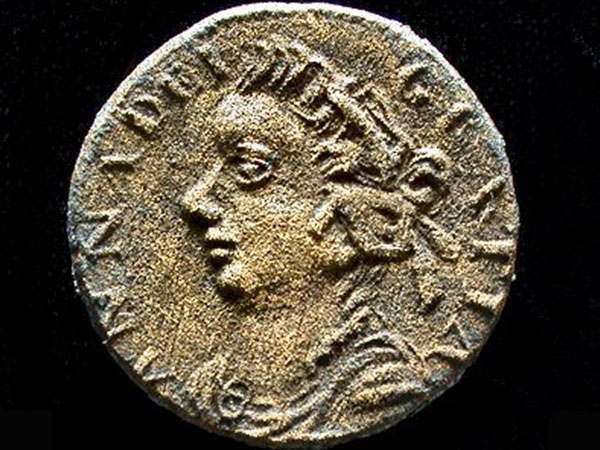 Photograph courtesy Wendy Welsh/N.C. Department of Cultural Resources.
Photograph courtesy Wendy Welsh/N.C. Department of Cultural Resources.Originally from: Site of possible Queen Anne’s Revenge wreckage.
Coin weights like this one, engraved with Queen Anne’s portrait, were used to verify the quality of metal currency.
Historians aren’t certain why Blackbeard named his ship Queen Anne’s Revenge. Some believe he named it for the monarch because she hired him to pillage from French and Spanish ships during the War of the Spanish Succession in the early 18th century.
-
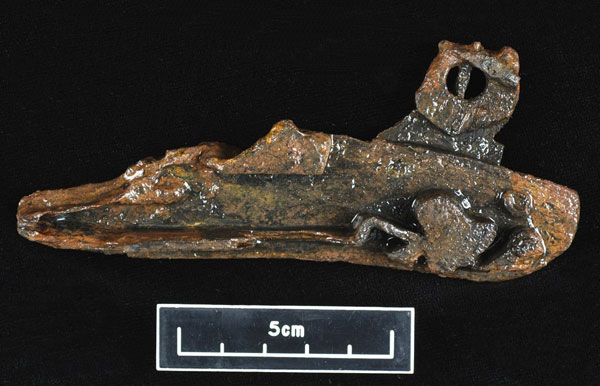 Photograph courtesy Wendy Welsh/N.C. Department of Cultural Resources.
Photograph courtesy Wendy Welsh/N.C. Department of Cultural Resources.Originally from: Site of possible Queen Anne’s Revenge wreckage.
Part of a flintlock mechanism, the firing device for the type gun that was popular in Blackbeard’s time. This revolutionary weapon, developed by the French a century earlier, used a mechanical device called a “lock” to strike flint against steel, creating a spark that would ignite a reserve of gunpowder. What you see here is the inside of the lock, which contained the spring that propelled the gun’s hammer.
-
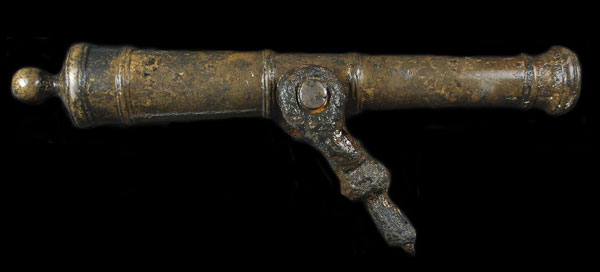 Photograph courtesy Wendy Welsh/N.C. Department of Cultural Resources.
Photograph courtesy Wendy Welsh/N.C. Department of Cultural Resources.Originally from: Site of possible Queen Anne’s Revenge wreckage.
A small signal cannon. Rather than fire ammunition at enemy ships, these cannons just created loud noises to communicate with other ships.
-
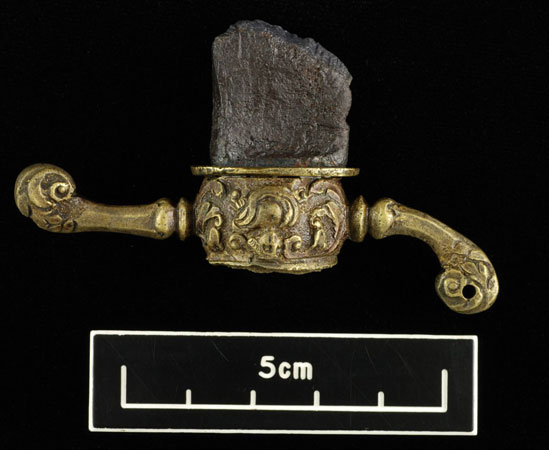 Photograph courtesy Wendy Welsh/N.C. Department of Cultural Resources.
Photograph courtesy Wendy Welsh/N.C. Department of Cultural Resources.Originally from: Site of possible Queen Anne’s Revenge wreckage.
This fragment of a dagger was recovered in 2008. Two years later, archeologists recovered a handle that may belong to this weapon. They’re currently trying to determine its composition, which may be antler.
-
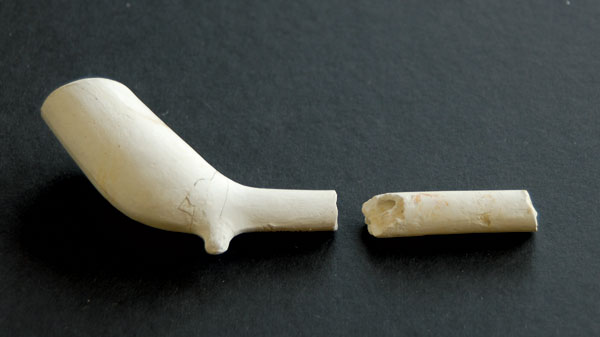 Photograph courtesy Wendy Welsh/N.C. Department of Cultural Resources.
Photograph courtesy Wendy Welsh/N.C. Department of Cultural Resources.Originally from: Site of possible Queen Anne’s Revenge wreckage.
White kaolin clay pipes like this one were used for smoking tobacco.
-
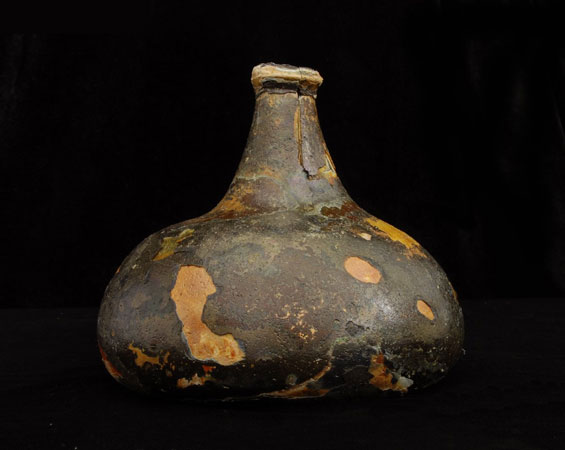 Photograph courtesy Wendy Welsh/N.C. Department of Cultural Resources.
Photograph courtesy Wendy Welsh/N.C. Department of Cultural Resources.Originally from: Site of possible Queen Anne’s Revenge wreckage.
Contrary to the image of the pirate on the rum-only diet, this bottle was probably for wine. It was nicknamed an “onion” bottle because of its shape.
-
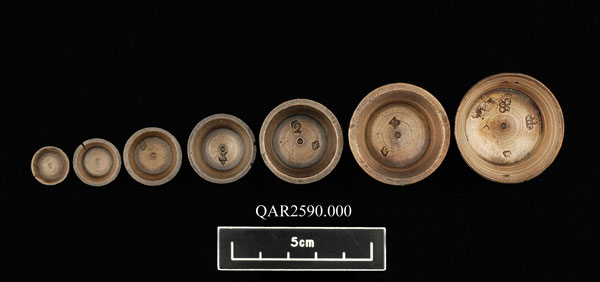 Photograph courtesy Wendy Welsh/N.C. Department of Cultural Resources.
Photograph courtesy Wendy Welsh/N.C. Department of Cultural Resources.Originally from: Site of possible Queen Anne’s Revenge wreckage.
These weights were used to measure gold and medication.
-
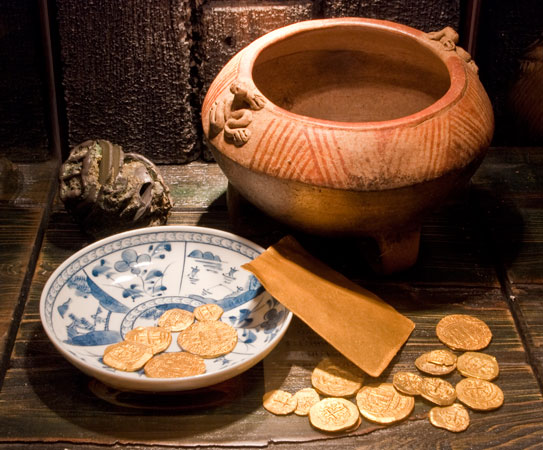 Photo courtesy the St. Augustine Pirate and Treasure Museum.
Photo courtesy the St. Augustine Pirate and Treasure Museum.Originally from: Unknown.
Pictured here is a South American pottery vessel from 1692 (back right), a gold sheet from the 18th century, a collection of gold coins from 1712, an oxidized clump of coins and buckles (back left), and a 17th-century Chinese export dish (front, left). While archaeologists cannot be certain these came from pirate ships, they were recovered from shipwreck sites off the Florida coast that date to the golden age of piracy. It’s unlikely that regular vessels traveled with such amassed riches on board.
-
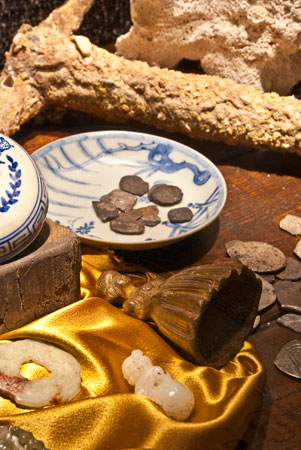 Photo courtesy the St. Augustine Pirate and Treasure Museum.
Photo courtesy the St. Augustine Pirate and Treasure Museum.Originally from: Unknown.
This collection of Spanish coins, bronze bell (middle), Chinese export plate (middle) and jade figurine (front) all date to the 17th century. In the background is an axe encrusted with centuries of sea debris.
-
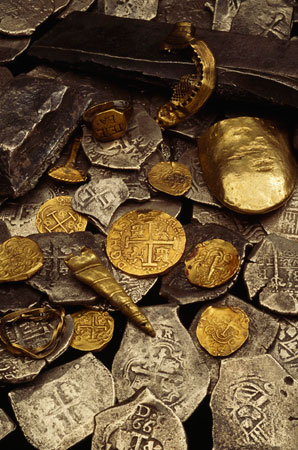 Photo by Bill Curtsinger/CREDIT: National Geographic. Currently on view at the Denver Museum of Nature and Science (part of the National Geographic's "Real Pirates" exhibition that runs through Aug. 21).
Photo by Bill Curtsinger/CREDIT: National Geographic. Currently on view at the Denver Museum of Nature and Science (part of the National Geographic's "Real Pirates" exhibition that runs through Aug. 21).Originally from: the Whydah.
These coins come from the shipwreck of Whydah, the first verifiable pirate ship discovered in the United States. Pirate Sam Bellamy and his crew captured the Whydah sometime in 1717 and took custody of at least 20,000 British pounds worth of sterling silver and gold. His thirst for gold unquenched, Bellamy continued pillaging ships in the Caribbean and Atlantic until later that year, when a storm sunk his ship off the coast of Cape Cod.
-
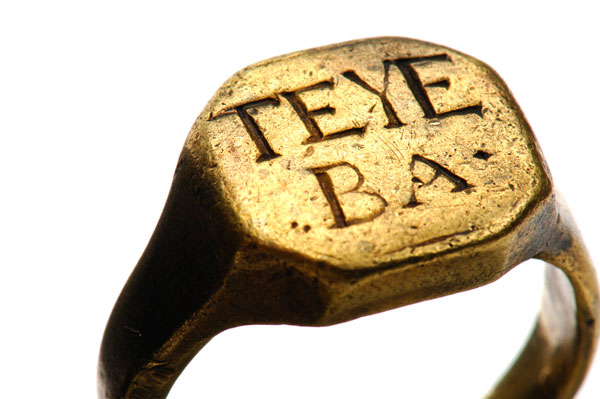 Photograph by Kenneth Garrett/CREDIT: National Geographic. Currently on view at the Denver Museum of Nature and Science (part of the National Geographic's "Real Pirates" exhibition that runs through Aug. 21).
Photograph by Kenneth Garrett/CREDIT: National Geographic. Currently on view at the Denver Museum of Nature and Science (part of the National Geographic's "Real Pirates" exhibition that runs through Aug. 21).Originally from: the Whydah.
Some think the letters on this ring are a Welsh abbreviation for “good luck,” while others believe it belonged to a Royal Navy rover named Teye, who later became a pirate himself.
-
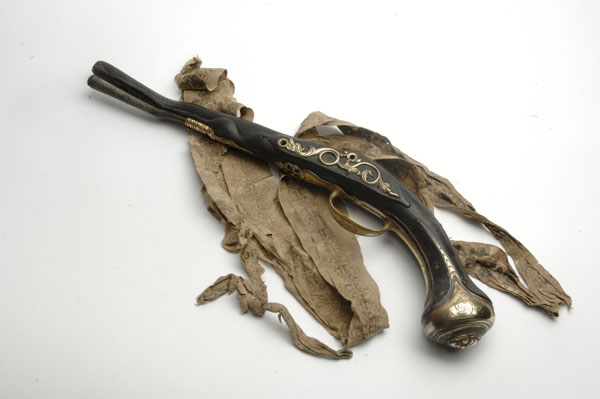 Photograph by Kenneth Garrett © 2008 CREDIT: National Geographic.Currently on view at the Denver Museum of Nature and Science (part of the National Geographic's "Real Pirates" exhibition that runs through Aug. 21).
Photograph by Kenneth Garrett © 2008 CREDIT: National Geographic.Currently on view at the Denver Museum of Nature and Science (part of the National Geographic's "Real Pirates" exhibition that runs through Aug. 21).Originally from: the Whydah.
Notice this pistol’s decorative knob.